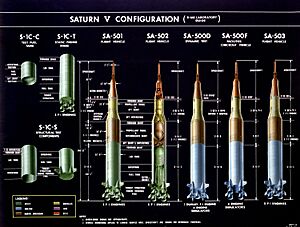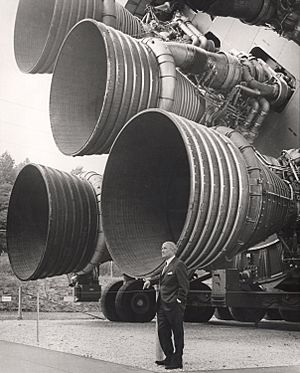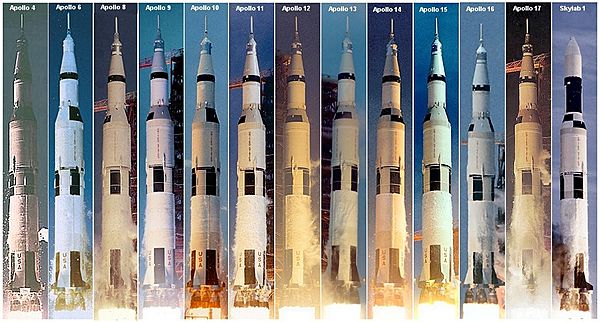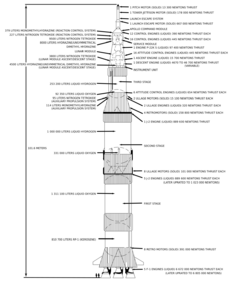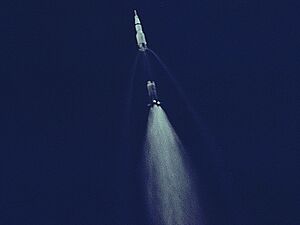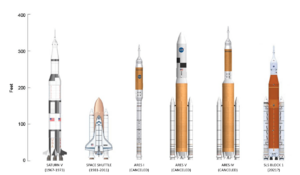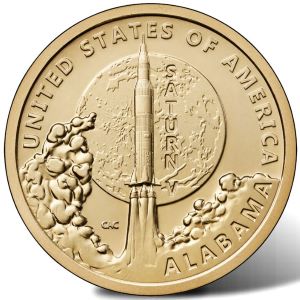Saturn V facts for kids
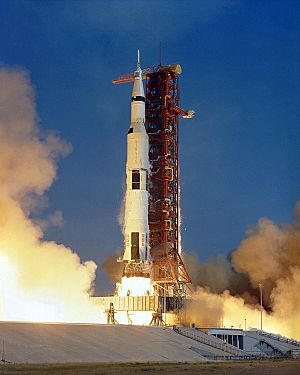
The launch of Apollo 11 on Saturn V SA-506, July 16, 1969
|
|
| Function |
|
|---|---|
| Manufacturer |
|
| Country of origin | United States |
| Project cost | US$6.417 billion (equivalent to $48 billion in 2022) |
| Cost per launch | US$185 million (equivalent to $1.394 billion in 2022) |
| Size | |
| Height | 363 ft (111 m) |
| Diameter | 33 ft (10 m) |
| Mass | 6,221,000 to 6,537,000 lb (2,822,000 to 2,965,000 kg) |
| Stages | 3 |
| Capacity | |
| Payload to LEO | 141,136 kg (311,152 lb) |
| Payload to TLI | 52,759 kg (116,314 lb) |
| Associated rockets | |
| Family | Saturn |
| Derivatives | Saturn INT-21 |
| Comparable |
|
| Launch history | |
| Status | Retired |
| Launch sites | Kennedy Space Center, LC-39 |
| Total launches | 13 |
| Successes | 12 |
| Partial failures | 1 (Apollo 6) |
| First flight | November 9, 1967 (AS-501 Apollo 4) |
| Last flight | May 14, 1973 (AS-513 Skylab) |
| First stage – S-IC | |
| Length | 138 ft (42 m) |
| Diameter | 33 ft (10 m) |
| Empty mass | 303,000 lb (137,000 kg) |
| Gross mass | 4,881,000 lb (2,214,000 kg) |
| Engines | 5 × F-1 |
| Thrust | 7,750,000 lbf (34,500 kN) sea level |
| Specific impulse | 263 s (2.58 km/s) sea level |
| Burn time | 168 seconds |
| Fuel | LOX / RP-1 |
| Second stage – S-II | |
| Length | 81.5 ft (24.8 m) |
| Diameter | 33 ft (10 m) |
| Empty mass | 88,400 lb (40,100 kg) |
| Gross mass | 1,093,900 lb (496,200 kg) |
| Engines | 5 × J-2 |
| Thrust | 1,155,800 lbf (5,141 kN) vacuum |
| Specific impulse | 421 s (4.13 km/s) vacuum |
| Burn time | 360 seconds |
| Fuel | LOX / LH2 |
| Third stage – S-IVB | |
| Length | 58.3 ft (17.8 m) |
| Diameter | 21.7 ft (6.6 m) |
| Empty mass | 33,600 lb (15,200 kg) |
| Gross mass | 271,000 lb (123,000 kg) |
| Engines | 1 × J-2 |
| Thrust | 232,250 lbf (1,033.1 kN) vacuum |
| Specific impulse | 421 s (4.13 km/s) vacuum |
| Burn time | 165 + 335 seconds (2 burns) |
| Fuel | LOX / LH2 |
The Saturn V was a giant American rocket used by NASA to send astronauts to the Moon. It was a three-stage rocket that used liquid fuel. From 1967 to 1973, it launched nine crewed missions to the Moon. It also launched Skylab, America's first space station.
As of 2024, the Saturn V is the only rocket that has ever carried humans beyond low Earth orbit (LEO). It holds the record for carrying the heaviest loads into low Earth orbit. This included the fuel needed to send the Apollo command and service module and Lunar Module to the Moon.
The Saturn V was the biggest rocket in the Saturn family. It was designed by Wernher von Braun and his team at the Marshall Space Flight Center in Huntsville, Alabama. Companies like Boeing, North American Aviation, Douglas Aircraft Company, and IBM helped build it. NASA built 15 flight-ready rockets, plus three for ground tests. Thirteen missions were launched from Kennedy Space Center. Nine of these missions took 24 astronauts to the Moon between December 1968 (with Apollo 8) and December 1972 (with Apollo 17).
Contents
How the Saturn V Rocket Was Developed
The Start of Rocket Science in the U.S.
In September 1945, the U.S. government brought German rocket expert Wernher von Braun and over 1,500 German engineers to the United States. This was part of a program called Operation Paperclip. Von Braun had helped create the German V-2 rocket. He worked for the Army's rocket design team. For many years, he mostly shared his knowledge of the V-2 with American engineers.
Things changed in 1957 when the Soviet Union launched Sputnik 1. This satellite was launched by an R-7 rocket, which could carry a nuclear warhead to the U.S. The U.S. Army and government then focused more on sending Americans into space before the Soviets. They turned to von Braun's team, who had developed the Jupiter series of rockets. In January 1958, the Juno I rocket launched the first American satellite. Von Braun saw the Jupiter rockets as early versions of the upcoming Saturn rockets. He even called them "an infant Saturn."
Designing the Saturn Rocket Family
The Saturn rockets were named after the sixth planet from the Sun. Their designs grew from the earlier Jupiter rockets.
Between 1960 and 1962, the Marshall Space Flight Center (MSFC) designed several Saturn rockets. These rockets could be used for missions around Earth or to the Moon.
NASA first thought about using the Saturn C-3 for a Moon mission. This plan would need at least two or three launches for one Moon landing. But the MSFC planned an even bigger rocket, the C-4. The C-4 would use four F-1 engines in its first stage. It would also have a larger C-3 second stage and a third stage called the S-IVB. The S-IVB would have a single J-2 engine. The C-4 would only need two launches for a Moon mission.
On January 10, 1962, NASA announced plans to build the C-5. This three-stage rocket would have:
- The S-IC first stage with five F-1 engines.
- The S-II second stage with five J-2 engines.
- The S-IVB third stage with one J-2 engine.
The C-5 would be tested in a special way called "all-up" testing. This meant the first test flight would use complete versions of all three stages. This method would save time and money by needing fewer test flights before a crewed launch.
In early 1962, the C-5 was chosen for the Apollo program and named the Saturn V. The C-1 became the Saturn I, and the C-1B became the Saturn IB. Von Braun led the team at MSFC to build this powerful rocket. The team decided to use multiple engines instead of a single engine, like the V-2.
The final design of the Saturn V used F-1 engines for the first stage. New liquid hydrogen J-2 engines were chosen for the second and third stages. NASA approved von Braun's Saturn designs, and the Apollo space program moved forward quickly.
Von Braun's Marshall Space Flight Center designed the stages. Different companies built them:
- Boeing built the S-IC (first stage).
- North American Aviation built the S-II (second stage).
- Douglas Aircraft built the S-IVB (third stage).
- IBM built the instrument unit.
Choosing the Best Way to Land on the Moon
NASA considered three main ways to get to the Moon:
- Earth orbit rendezvous (EOR): Launching the spacecraft in two smaller parts and joining them in Earth orbit.
- Direct ascent: Using one huge rocket to send a three-person spacecraft directly to the Moon.
- Lunar orbit rendezvous (LOR): Launching two spacecraft with one rocket: a main ship and a smaller, two-person landing module. The lander would go to the Moon's surface and then return to the main ship in lunar orbit. The lander would then be left behind, and the main ship would come back to Earth.
At first, NASA worried about LOR because no one had ever done a space rendezvous, especially not in orbit around the Moon. But engineers like John Houbolt and NASA official George Low argued that LOR was the simplest and most cost-effective way to land on the Moon. It also gave the best chance to reach the Moon within the decade. Other NASA officials agreed. On November 7, 1962, NASA Administrator James E. Webb officially chose LOR for the Apollo program.
Arthur Rudolph became the project director for the Saturn V rocket in August 1963. He set the requirements for the rocket and the Apollo mission plan. The first Saturn V launched perfectly on November 9, 1967, which was Rudolph's birthday. On July 16, 1969, a Saturn V launched Apollo 11, which put the first humans on the Moon.
Saturn V Launch History
| Rocket Number |
Mission | Launch Date (UTC) |
Launch Pad | Notes |
|---|---|---|---|---|
| SA-500F | Ground Testing | Used to check how well the rocket parts fit and to test the launch pad at 39A. | ||
| SA-500D | Vibration Testing | Used to see how the rocket reacted to shaking. It is now on display in Huntsville, Alabama. | ||
| S-IC-T | Engine Test | The first stage was used for a static test firing. It is now on display at Kennedy Space Center. | ||
| SA-501 | Apollo 4 | November 9, 1967 12:00:01 |
39A | First uncrewed test flight; it was a complete success. |
| SA-502 | Apollo 6 | April 4, 1968 12:00:01 |
39A | Second uncrewed test flight. There were engine problems in the second stage, and the third stage could not restart. |
| SA-503 | Apollo 8 | December 21, 1968 12:51:00 |
39A | First crewed flight. It was the first time a spacecraft was sent towards the Moon. |
| SA-504 | Apollo 9 | March 3, 1969 16:00:00 |
39A | Crewed test of the full Apollo spacecraft with the Lunar Module in Earth orbit. |
| SA-505 | Apollo 10 | May 18, 1969 16:49:00 |
39B | Second crewed flight towards the Moon with the full Apollo spacecraft and Lunar Module. Only Saturn V launched from Pad 39B. |
| SA-506 | Apollo 11 | July 16, 1969 13:32:00 |
39A | First crewed Moon landing, at Sea of Tranquility. |
| SA-507 | Apollo 12 | November 14, 1969 16:22:00 |
39A | The rocket was hit by lightning twice after liftoff, but it was not badly damaged. It made the second crewed Moon landing. |
| SA-508 | Apollo 13 | April 11, 1970 19:13:03 |
39A | Engine problems in the second stage caused an early shutdown of one engine. The mission to the Moon was stopped due to a problem with the spacecraft. |
| SA-509 | Apollo 14 | January 31, 1971 21:03:02 |
39A | Third crewed Moon landing. |
| SA-510 | Apollo 15 | July 26, 1971 13:34:00 |
39A | Fourth crewed Moon landing. This was the first longer Apollo mission, carrying a lunar rover. |
| SA-511 | Apollo 16 | April 16, 1972 17:54:00 |
39A | Fifth crewed Moon landing. |
| SA-512 | Apollo 17 | December 7, 1972 05:33:00 |
39A | Only night launch. Sixth and final crewed Moon landing. |
| SA-513 | Skylab 1 | May 14, 1973 17:30:00 |
39A | Uncrewed launch of the Skylab space station. This rocket was originally planned for a canceled Apollo mission. |
| SA-514 | Not Used | Originally for a canceled Apollo mission. Parts are on display at Johnson Space Center and Kennedy Space Center. | ||
| SA-515 | Not Used | Originally for a canceled Apollo mission. Parts are on display at Infinity Science Center and National Air and Space Museum. | ||
What Made the Saturn V So Big?
The Saturn V was much bigger and could carry more weight than any other rocket before it. With the Apollo spacecraft on top, it stood 363 feet (111 m) tall. This is taller than the Statue of Liberty (from the ground to the torch) and the Elizabeth Tower (Big Ben). The rocket was 33 feet (10 m) wide. When fully fueled, it weighed 6.5 million pounds (2,900,000 kg). It was designed to send at least 90,000 pounds (41,000 kg) to the Moon. Later, it could send even more.
The Marshall Space Flight Center in Huntsville, Alabama designed the Saturn V. Many other companies designed its major systems, like the engines. The rocket used the very powerful F-1 and J-2 rocket engines. During tests, the sound from these engines was so strong it broke windows in nearby houses. Designers tried to use as much technology from the Saturn I program as possible. For example, the S-IVB third stage of the Saturn V was based on the Saturn IB's second stage.
The Saturn V was mostly made of aluminum. It also used titanium, polyurethane, cork, and asbestos. You can find blueprints and plans for the rocket on microfilm at the Marshall Space Flight Center.
The Saturn V had three main parts, called stages:
- The S-IC first stage.
- The S-II second stage.
- The S-IVB third stage.
- It also had an instrument unit that acted as its brain.
All three stages used liquid oxygen (LOX) as an oxidizer. The first stage used RP-1 (a type of kerosene) for fuel. The second and third stages used liquid hydrogen (LH2). LH2 gives more energy per pound, which is good for higher orbits and going to the Moon. RP-1 gives more energy per gallon and more thrust, which is better for the first part of the launch. If the first stage used LH2, it would need much larger tanks, which was not possible at the time. The upper stages also used small solid rockets to help separate the stages and move the fuel into place.
The S-IC First Stage
The Boeing Company built the S-IC at the Michoud Assembly Facility in New Orleans, Louisiana. Most of its weight at launch was fuel: RP-1 and liquid oxygen. This stage was 138 feet (42 m) tall and 33 feet (10 m) wide. It produced 7,750,000 lbf (34,500 kN) of thrust at sea level. The S-IC stage weighed about 303,000 pounds (137,000 kilograms) empty. When full of fuel, it weighed 4,881,000 pounds (2,214,000 kilograms).
The S-IC had five Rocketdyne F-1 engines. One engine was in the center and stayed still. The four outer engines could move to steer the rocket. During flight, the center engine shut down about 26 seconds earlier than the others. This helped control the rocket's acceleration. The S-IC fired its engines for 168 seconds. At cutoff, the rocket was about 42 miles (67 km) high and moving around 7,500 feet per second (2,300 m/s).
The S-II Second Stage
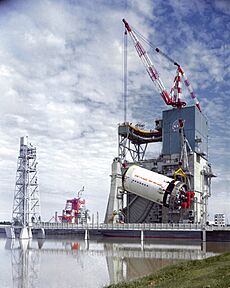
North American Aviation built the S-II stage in Seal Beach, California. It used liquid hydrogen and liquid oxygen. It also had five Rocketdyne J-2 engines, similar to the S-IC. The four outer engines could also move for steering. The S-II was 81.6 feet (24.87 m) tall and 33 feet (10 m) wide, the same width as the S-IC. It was the largest cryogenic (super-cold fuel) stage until the Space Shuttle launched in 1981.
The S-II weighed about 80,000 pounds (36,000 kg) empty. When full of fuel, it weighed 1,060,000 pounds (480,000 kg). More than 90 percent of its weight was fuel. This lightweight design caused some problems in early tests. Instead of two separate tanks, the S-II used a single shared wall, called a common bulkhead. This wall separated the liquid oxygen tank from the liquid hydrogen tank. It had to keep the 126 °F (70 °C) temperature difference between the two tanks. Using a common bulkhead saved 7,900 pounds (3.6 t) of weight. Like the S-IC, the S-II was shipped by sea to Cape Kennedy.
The S-IVB Third Stage

The Douglas Aircraft Company built the S-IVB stage in Huntington Beach, California. It had one Rocketdyne J-2 engine and used the same fuel as the S-II (liquid hydrogen and liquid oxygen). The S-IVB also used a common bulkhead to separate its two fuel tanks. It was 58.6 feet (17.86 m) tall and 21.7 feet (6.604 m) wide. The S-IVB weighed about 23,000 pounds (10,000 kg) empty. When full of fuel, it weighed about 262,000 pounds (119,000 kg).
The S-IVB was the only Saturn V rocket stage small enough to be carried by the Aero Spacelines Pregnant Guppy cargo plane.
For missions to the Moon, the S-IVB engine fired twice. First, it pushed the spacecraft into Earth orbit. Second, it fired again to send the spacecraft towards the Moon.
The Instrument Unit: The Rocket's Brain
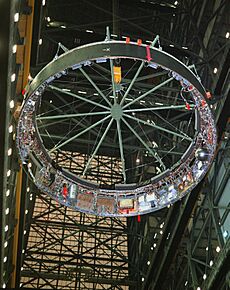
IBM built the Saturn V's instrument unit at the Space Systems Center in Huntsville, Alabama. This computer controlled the rocket's actions from just before launch until the S-IVB stage was separated. It had systems for guidance and telemetry (sending data back to Earth). By measuring how the rocket was accelerating and its direction, it could figure out the rocket's position and speed. It could also correct any mistakes.
How the Saturn V Was Put Together
After each stage was built and tested, it was shipped to the Kennedy Space Center. The first two stages were so big they could only be moved by barge. The S-IC, built in New Orleans, traveled down the Mississippi River to the Gulf of Mexico.
Then, it went around Florida and up the Intra-Coastal Waterway to the Vehicle Assembly Building (VAB). The S-II, built in California, traveled through the Panama Canal to Florida. The third stage and Instrument Unit were carried by special cargo planes, the Aero Spacelines Pregnant Guppy and Super Guppy.
When they arrived at the VAB, each stage was checked while lying flat. Then, they were stood upright. NASA also built large dummy stages that could be used if a real stage was delayed. These dummies had the same height, weight, and electrical connections as the real stages.
NASA put the Saturn V together on a Mobile Launcher. This platform had a Launch Umbilical Tower with nine arms, a crane, and a water system to reduce sound during launch. Once assembled, the entire rocket and launcher were moved from the VAB to the launch pad. This was done using the Crawler Transporter (CT). The CT was built by the Marion Power Shovel Company. It ran on four double-tracked treads, each with 57 "shoes" that weighed 2,000 pounds (910 kg) each. The CT also had to keep the rocket level as it traveled the 3 miles (4.8 km) to the launch site, especially on the 3 percent slope at the launch pad.
The Cost of the Saturn V
From 1964 to 1973, about $6.417 billion was spent on developing and flying the Saturn V. The most money was spent in 1966, with $1.2 billion. In that same year, NASA received its largest budget ever, $4.5 billion. This was about 0.5 percent of the total money earned by the United States at that time.
Two main reasons why the last three Apollo missions were canceled were the high cost of the Saturn V and the increasing costs of the Vietnam War. Between 1969 and 1971, launching a Saturn V Apollo mission cost between $185 million and $189 million. About $110 million of that was just for building the rocket.
How a Moon Mission Launched
The Saturn V launched all Apollo Moon missions from Launch Complex 39 at the John F. Kennedy Space Center in Florida. After the rocket left the launch tower, control moved to Mission Control in Houston, Texas. An average mission used the rocket for only about 20 minutes. Even when Apollo 6 had three engine failures and Apollo 13 had one, the rocket's computers could make up for it by burning the other engines longer to reach orbit.
Safety During Launch
If something went wrong and the rocket needed to be destroyed, a safety officer could send a signal. This signal would first shut down the engines. After a few seconds, another command would detonate explosives on the rocket's outer surface. These explosives would cut the fuel and oxidizer tanks to spread the fuel quickly and prevent a big explosion. The short delay gave the crew time to escape using the Launch Escape Tower. Later in the flight, they could use the Service Module's engines to escape. A third command, "safe," was used after the third stage reached orbit to turn off the self-destruct system for good. The system was also turned off while the rocket was on the launch pad.
The Launch Sequence

The first stage burned for about 2 minutes and 41 seconds. It lifted the rocket to an altitude of 42 miles (68 km) and a speed of 6,164 miles per hour (2,756 m/s). It burned 4,700,000 pounds (2,100,000 kg) of fuel.
At 8.9 seconds before launch, the first stage engines began to ignite. The center engine lit first, then the other four in pairs. Once the computers confirmed enough thrust, the rocket was "soft-released." First, the hold-down arms let go. Then, as the rocket started to move up, it was slowed slightly by metal pins for half a second.
Once the rocket lifted off, it could not safely land back on the pad if the engines failed. Astronauts felt this was one of the most stressful parts of riding the Saturn V. If it failed to lift off after release, their chances of survival were low due to the huge amount of fuel. To make it safer, the Saturn Emergency Detection System (EDS) kept the engines from shutting down for the first 30 seconds of flight. The noise from the launch was very loud, but it could not melt concrete, as some myths suggest.
It took about 12 seconds for the rocket to clear the launch tower. During this time, it tilted slightly away from the tower to avoid hitting it, even in strong winds. At 430 feet (130 m) high, the rocket rolled to the correct flight direction. Then it gradually tilted down until 38 seconds after the second stage ignited. This tilt was set based on the winds for that month.
The four outer engines also tilted outwards. This was so that if one engine shut down early, the remaining engines would still push the rocket evenly. The Saturn V reached 400 feet per second (120 m/s) at over 1 mile (1,600 m) high. Most of the early flight was about gaining height, with speed coming later. The Saturn V broke the sound barrier just over 1 minute into flight, at an altitude of 3.45 and 4.6 miles (5.55 and 7.40 km). At this point, shock collars, or condensation clouds, would form around the rocket.
Max Q and Stage Separation
At about 80 seconds into flight, the rocket experienced maximum dynamic pressure (max q). This is when the air pushing against the rocket is strongest. Even though the rocket kept getting faster, the air became thinner higher up, so the pressure dropped after max q.
The fuel in the S-IC first stage made up about three-quarters of the Saturn V's total weight at launch. It was used up at 13,000 kilograms per second (1,700,000 lb/min). As the rocket lost weight (and the engine power increased), its acceleration went up. At launch, the acceleration was about 1.25 g. This means astronauts felt 1.25 times their normal weight. As the rocket quickly lost weight, the total acceleration increased to almost 4 g at 135 seconds. At this point, the center engine was shut down to keep the acceleration from going over 4 g.
When the fuel or oxidizer ran low, the remaining four outer engines shut down. The first stage separated less than a second later. Eight small solid rockets pushed the S-IC away from the rest of the rocket. The first stage then fell into the Atlantic Ocean about 350 miles (560 km) away.
For the Skylab launch, the engine shutdown was changed to protect the Apollo Telescope Mount. Instead of all four outer engines shutting down at once, they shut down two at a time. This further reduced the acceleration.
The S-II Second Stage Sequence
After the S-IC separated, the S-II second stage burned for 6 minutes. It pushed the spacecraft to 109 miles (175 km) high and 15,647 mph (25,181 km/h), which is almost orbital velocity.
For the first two uncrewed launches, eight small solid-fuel rockets fired for four seconds to help the S-II stage accelerate. Then, its five J-2 engines ignited. For the first seven crewed Apollo missions, only four of these small rockets were used. They were removed completely for the last four launches. About 30 seconds after the first stage separated, the interstage ring (a connecting part) dropped away from the second stage. This was done carefully so it wouldn't hit the J-2 engines. Soon after, the Launch Escape System was also dropped.
About 38 seconds after the second stage ignited, the Saturn V switched to a "closed loop" guidance system. The instrument unit now calculated the best path to orbit in real-time to save fuel. If the instrument unit failed, the crew could use the command module's computer, take manual control, or stop the flight.
About 90 seconds before the second stage shut down, the center engine turned off. This helped reduce shaking inside the rocket. Around this time, the flow of liquid oxygen was reduced. This made sure that very little fuel was left in the tanks when the second stage finished its burn.
Five sensors in the S-II fuel tanks were activated during flight. When two of them were uncovered (meaning fuel was low), they would trigger the S-II to shut down and separate. One second after the second stage shut down, it separated. A few seconds later, the third stage ignited. Small solid rockets on the S-II pushed it away from the S-IVB. The S-II then fell into the ocean about 2,600 miles (4,200 km) from the launch site.
During the Apollo 13 mission, the center engine had severe shaking problems and shut down early. To make sure the rocket reached enough speed, the other four engines burned longer than planned. A device to reduce shaking was added to later Apollo missions.
The S-IVB Third Stage Sequence
Unlike the first two stages, the S-II and S-IVB stages separated in one step. The interstage, though built with the third stage, stayed attached to the second stage. The third stage did not use much fuel to get into Low Earth Orbit (LEO) because the second stage had done most of the work.
On Apollo 11, a typical Moon mission, the third stage burned for about 2.5 minutes. It shut down at 11 minutes and 40 seconds into the flight. At this point, the rocket was 1,645.61 miles (2,648.35 km) away and in a parking orbit 118 miles (190 km) high, moving at 17,432 miles per hour (28,054 km/h). The third stage stayed connected to the spacecraft as it orbited Earth one and a half times. This gave astronauts and mission controllers time to prepare for the trip to the Moon.
For the last three Apollo flights, the temporary parking orbit was even lower (about 107 miles or 172 kilometers). This used a trick called the Oberth effect to carry more weight. The Apollo 9 Earth orbit mission launched into a similar orbit as Apollo 11. However, its spacecraft used its own engines to raise its orbit high enough for a 10-day mission. Skylab was launched into a very different orbit, 270-mile (434 km) high, which kept it in space for six years.
Lunar Module and Skylab Missions
On Apollo 11, the burn to send the spacecraft to the Moon happened 2 hours and 44 minutes after launch. The S-IVB burned for almost six minutes. This gave the spacecraft a speed close to Earth's escape velocity (25,053 mph (40,319 km/h)). This made the trip to the Moon very efficient, with the Moon's gravity helping to pull the spacecraft in.
About 40 minutes after this burn, the Apollo command and service module (CSM) separated from the third stage. It then turned around and connected with the Lunar Module (LM), which was carried below the CSM during launch. The CSM and LM separated from the used third stage 50 minutes later. This was called the transposition, docking, and extraction maneuver.
If the S-IVB stayed on the same path, it could hit the spacecraft. So, its remaining fuel was vented, and small engines fired to push it away. For Moon missions before Apollo 13, the S-IVB was aimed to pass behind the Moon. The Moon's gravity would then slingshot it beyond Earth's pull and into orbit around the Sun. From Apollo 13 onwards, controllers aimed the S-IVB to crash into the Moon. Seismometers (devices that detect ground movement) left by earlier missions detected these impacts. This information helped scientists learn about the internal structure of the Moon.
Skylab Space Station
In 1965, the Apollo Applications Program (AAP) was created to find ways to use Apollo hardware for science missions. Much of the planning focused on a space station. Early plans involved using a spent S-II Saturn V second stage as a "wet workshop" that would be set up in space. By 1969, cuts to Apollo funding meant that some Moon landing flights were canceled. This freed up at least one Saturn V. So, the "wet workshop" idea was replaced with a "dry workshop" concept. The station, now called Skylab, would be built on the ground from a spare Saturn IB second stage. It would then be launched on the first two stages of a Saturn V. A backup station, made from a Saturn V third stage, was also built. It is now on display at the National Air and Space Museum.
Skylab was the only launch not directly related to the Apollo Moon landing program. The Saturn V only had minor changes for this mission. The S-II stage was modified to put Skylab into Earth orbit. It also vented extra fuel after engine cutoff so the stage wouldn't break apart in orbit. The S-II stayed in orbit for almost two years before falling back to Earth on January 11, 1975.
Three crews lived on Skylab from May 25, 1973, to February 8, 1974. Skylab itself remained in orbit until July 11, 1979.
Future Rocket Ideas After Saturn V
After the Apollo program, the Saturn V was planned to launch other missions. These included Prospector, a proposed robotic rover to the Moon. It was also considered for testing nuclear rocket stages like RIFT and NERVA. However, all these plans for the Saturn V were canceled, mainly due to cost.
If a second set of Saturn Vs had been built, they would likely have used the F-1A engine in the first stage. This would have given them a big power boost. Other changes might have included removing the fins (which didn't help much for their weight) and stretching the S-IC first stage.
Many other Saturn rocket ideas were proposed based on the Saturn V. These ranged from smaller versions like the Saturn INT-20 to huge ones like the Saturn V-23(L). The V-23(L) would have had five F-1 engines in its first stage, plus four extra boosters, each with two F-1 engines. This would mean 13 F-1 engines firing at launch!
Since no more Saturn Vs were built, the United States was left without a super heavy-lift rocket for a long time. Some space experts regretted this, as continued production could have made building the International Space Station much easier. The Saturn-Shuttle idea, for example, could have removed the need for the Space Shuttle Solid Rocket Boosters. These boosters were involved in the Challenger accident in 1986.
New Rockets Like the Saturn V
Post-Apollo Rocket Concepts
From the late 1950s to the early 1980s, U.S. plans for rockets larger than the Saturn V were often called Nova. More than thirty different Nova rocket ideas were proposed, but none were built.
Wernher von Braun also planned a rocket with eight F-1 engines in its first stage, like the Saturn C-8. This would have allowed a direct ascent flight to the Moon. Other ideas for the Saturn V included using a Centaur as an upper stage or adding extra boosters. These improvements would have allowed launching large robotic spacecraft to the outer planets or sending astronauts to Mars. The Saturn MLV family of "Modified Launch Vehicles" was also studied. These would have almost doubled the Saturn V's lifting power and were planned for a proposed mission to Mars by 1980.
In 1968, Boeing studied another Saturn V idea, the Saturn C-5N. This rocket would have used a nuclear thermal rocket engine for its third stage. The Saturn C-5N could carry much more weight for interplanetary spaceflight. Work on nuclear engines and all Saturn V plans ended in 1973.
The Comet HLLV was a huge heavy lift launch vehicle designed in the early 1990s. It was based on the Saturn V and could carry more than twice the payload. It would have used updated versions of Apollo's engines and stretched fuel tanks. Its main goal was to support the First Lunar Outpost program and future crewed Mars missions. It was designed to be as cheap and easy to use as possible.
The Ares Rocket Family
In 2006, NASA planned to build two rockets called Ares I and Ares V as part of the Constellation program. These rockets would use parts from the Space Shuttle and Saturn V. The Ares I was for crew launches, and the Ares V was for cargo. The original Ares V, named after the Saturn V, was 360 feet (110 m) tall. It had a core stage like the Space Shuttle External Tank, 28 feet (8.4 m) wide. It was powered by five RS-25 engines and two five-segment Space Shuttle Solid Rocket Boosters (SRBs). Later, the RS-25 engines were replaced with five RS-68 engines, which were cheaper and more powerful. This change meant the core stage had to be wider, 33 ft (10 m), the same as the Saturn V's first two stages.
In 2008, NASA redesigned the Ares V again. They made the core stage longer, added a sixth RS-68 engine, and made the SRBs longer. This new Ares V would have been 381 feet (116 m) tall. It would have produced about 8,900,000 lbf (40 MN) of thrust at liftoff. This was more than the Saturn V, but less than the Soviet N-1. The Ares V was expected to put about 400,000 pounds (180 t) into orbit, which would have been more than the Saturn V. An upper stage, the Earth Departure Stage, would have used a more advanced J-2 engine called the J-2X. The Ares V would have launched the Altair lunar lander into Earth orbit. An Orion crew vehicle, launched on Ares I, would then connect with Altair. The Earth Departure Stage would then send them to the Moon.
The Space Launch System (SLS)
After the Constellation program was canceled, NASA announced the Space Launch System (SLS). This is a heavy-lift rocket for exploring space beyond Earth orbit. The SLS is similar to the original Ares V idea. It is powered by four RS-25 engines and two five-segment SRBs. Its first version, Block 1, can lift about 209,000 pounds (95 t) to LEO. The Block 1B version will add the Exploration Upper Stage with four RL10 engines to lift even more. A future Block 2 version will use advanced boosters to lift at least 290,000 pounds (130 t) to LEO.
One idea for advanced boosters is to use a new version of the Saturn V's F-1 engine, called the F-1B. This would increase the SLS payload to about 330,000 pounds (150 t) to LEO. The F-1B is designed to be more efficient and cheaper than the original F-1. It has a simpler design and fewer parts. It would produce 1,800,000 lbf (8.0 MN) of thrust at sea level, which is more than the F-1 engine used on Apollo 15.
Where to See Saturn V Rockets
You can see parts of Saturn V rockets in different places:
- There are two displays at the U.S. Space & Rocket Center in Huntsville, Alabama:
- SA-500D is displayed horizontally. It is made of test stages that were not meant for flight. It was outside from 1969 to 2007, then restored and moved inside the Davidson Center for Space Exploration.
- A full-size replica (copy) built in 1999 is displayed vertically nearby.
- One Saturn V is at the Johnson Space Center in Houston, Texas. It uses the first stage from SA-514, the second stage from SA-515, and the third stage from SA-513 (which was replaced by the Skylab workshop for its flight). This rocket was displayed outside until 2005, when a building was built around it for protection. This is the only display Saturn made entirely of stages that were meant to be launched.
- Another one is at the Kennedy Space Center Visitor Complex in Florida. It is made of the S-IC-T (a test stage) and the second and third stages from SA-514. It was displayed outside for many years, then enclosed in 1996 in the Apollo/Saturn V Center.
- The S-IC stage from SA-515, which was at the Michoud Assembly Facility in New Orleans, is now on display at the Infinity Science Center in Mississippi.
- The S-IVB stage from SA-515 was changed to be a backup for Skylab. It is now on display at the National Air and Space Museum in Washington, D.C.
Images for kids
-
Complete Saturn V rocket display. Temporary exposition at the Kennedy Space Center.
-
Saturn V display, Johnson Space Center.
-
SA-500D (S-IC-D, S-II-F/D and S-IVB-D), U.S. Space & Rocket Center, Huntsville.
-
S-IC-T (test stage) and second and third stages from SA-514, Kennedy Space Center Visitor Complex.
-
S-IVB stage from SA-515, converted for use as Skylab B, National Air and Space Museum.
-
Saturn V main rockets, Kennedy Space Center Visitor Complex.
Discarded Rocket Parts
On September 3, 2002, astronomer Bill Yeung found what he thought was an asteroid. It was named J002E3. It seemed to be orbiting Earth. Scientists soon found that it was covered in white titanium dioxide paint, which was used on the Saturn V. After calculating its orbit, they thought it might be the Apollo 12 S-IVB stage. Mission controllers had planned to send Apollo 12's S-IVB into orbit around the Sun after it separated from the spacecraft. But it seems the engine burn lasted too long, and it didn't go close enough to the Moon. So, it stayed in a slightly unstable orbit around Earth and the Moon. In 1971, it is believed to have moved into orbit around the Sun. Then, 31 years later, it returned to Earth's orbit for a short time. It left Earth orbit again in June 2003.
See Also
 In Spanish: Saturno V para niños
In Spanish: Saturno V para niños
- Comparison of orbital launchers families
- Comparison of orbital launch systems
- Space exploration
- Comet HLLV (a Saturn-derived launch vehicle design from the 1990s)


